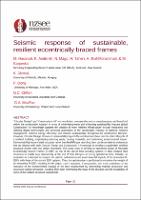| dc.description.abstract | “Circular design” and “Construction 4.0” are two distinct concepts that can be complementary and beneficial within the construction industry while prioritising sustainability. Nascent global Construction 4.0 knowledge supports the creation of more resilient infrastructure through integrating and utilising digital technologies and advanced automation in the construction industry to optimise resource management, improve energy efficiency, and enhance sustainability throughout the construction lifecycle. However, Circular design focuses on sustainability beyond the construction phase into the entire lifecycle of a resilient building, emphasising reducing waste, reusing materials, and minimising environmental impact. Demountability/reuse of steel structures rather than landfilling or recycling them can be considered endeavours that are aligned with both Circular design and Construction 4.0 concepts to develop a sustainable, resilient structural system with low carbon emissions. This study aims to develop an optimised design of Reusable Eccentrically Braced Frames (REBF) as one of the lateral force-resisting systems in New Zealand steel structures to enable easy disassembly at the end of their lifecycle or during operational time. The optimisation is performed to minimise the weight, resulting in the project cost’s reduction, of an innovative REBF, designed per the NZS-3404 standard and HERA-Report-P4001. Subsequently, optimising the mass of a structure can also affect the size and length of the required welding connections. Consequently, this work contributes to the reduction of the environmental impacts of the built environment by minimising material production and associated carbon emissions, resulting from both minimising the mass of the structure and the reusability of some of the resilient structural components. | |

